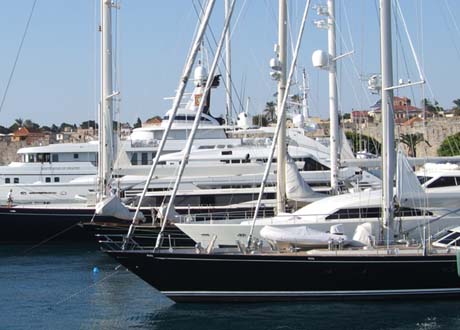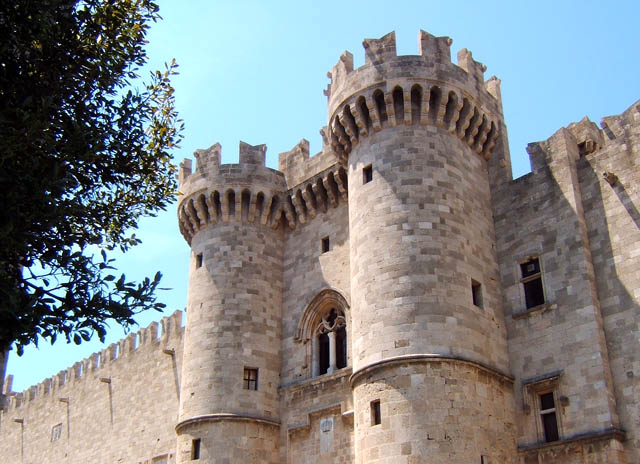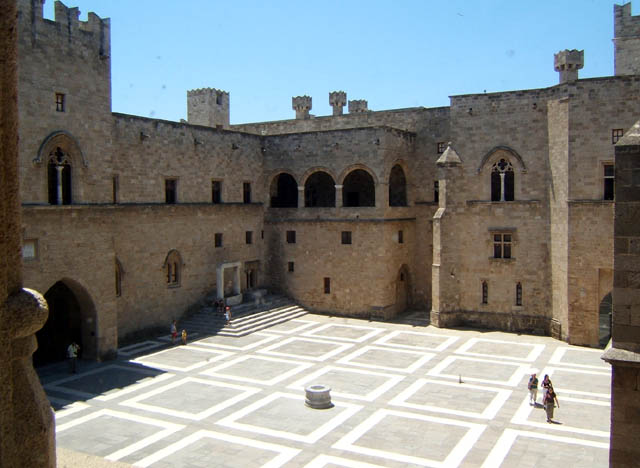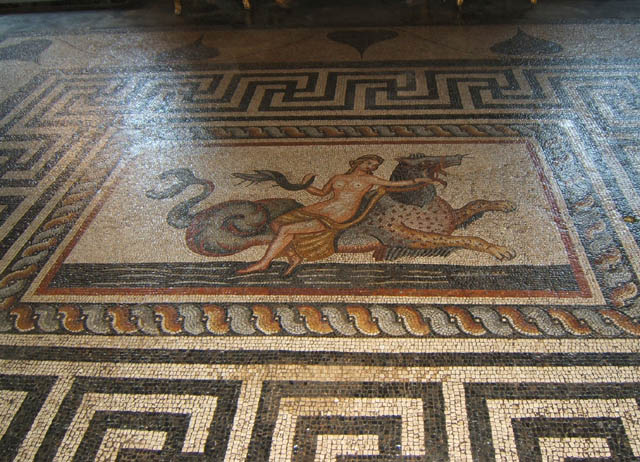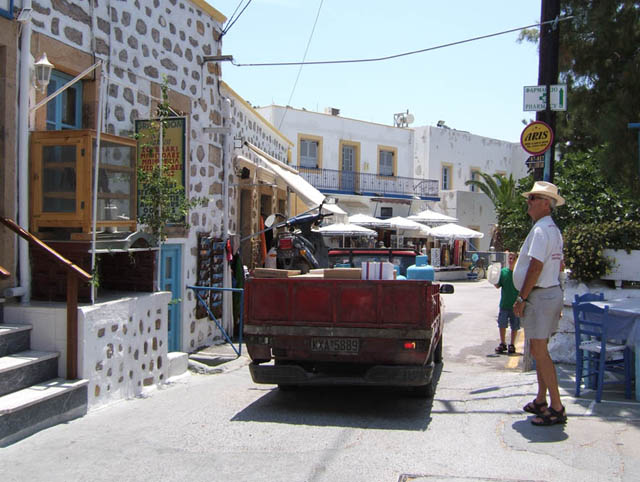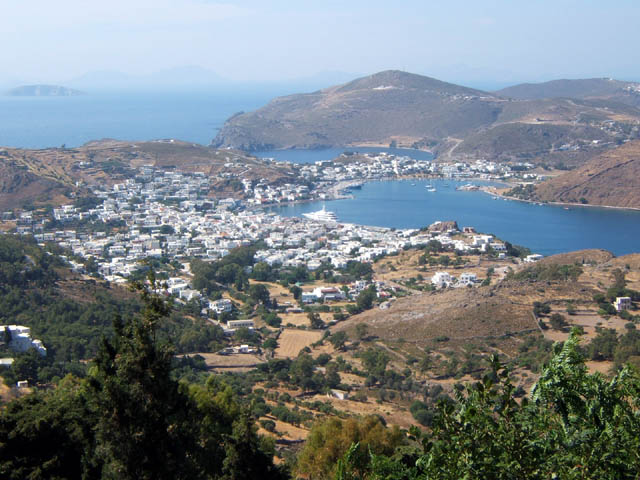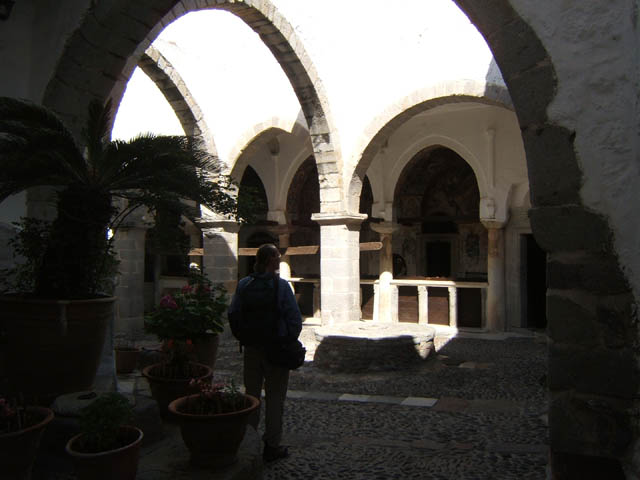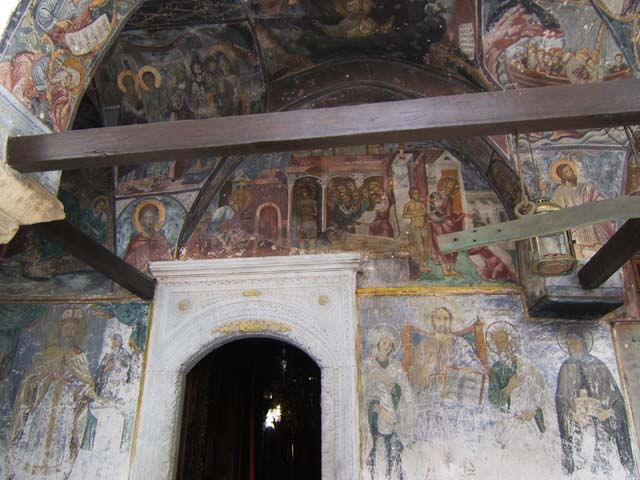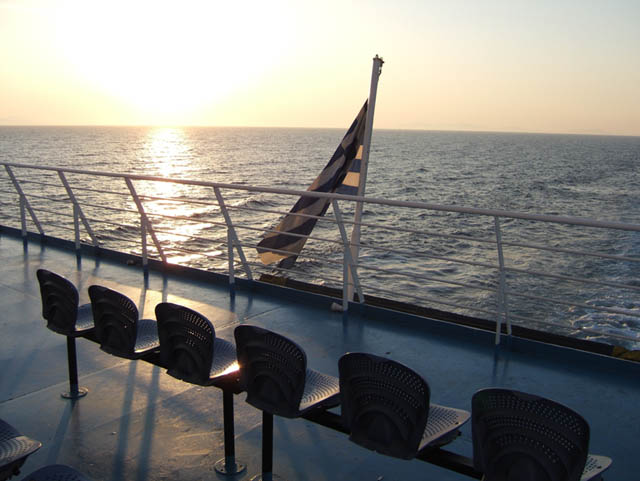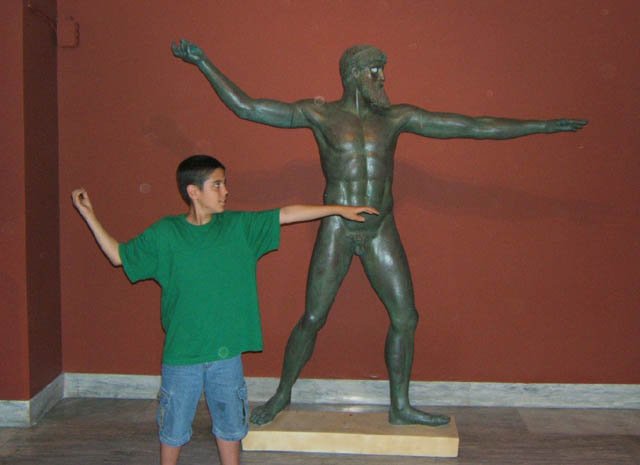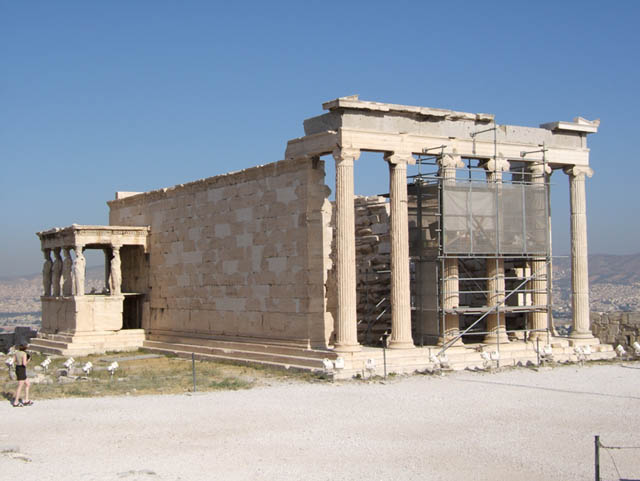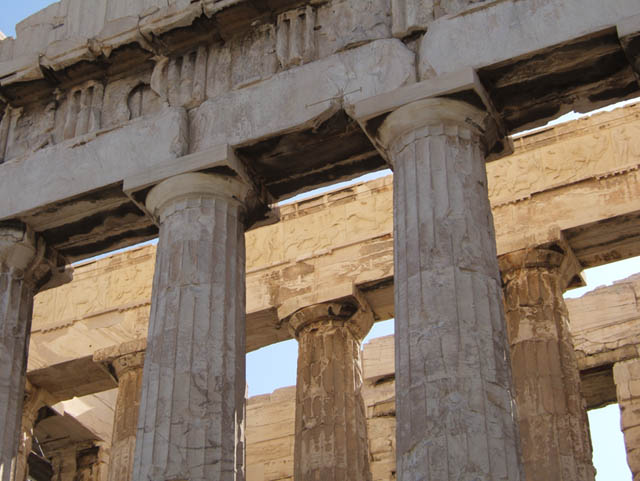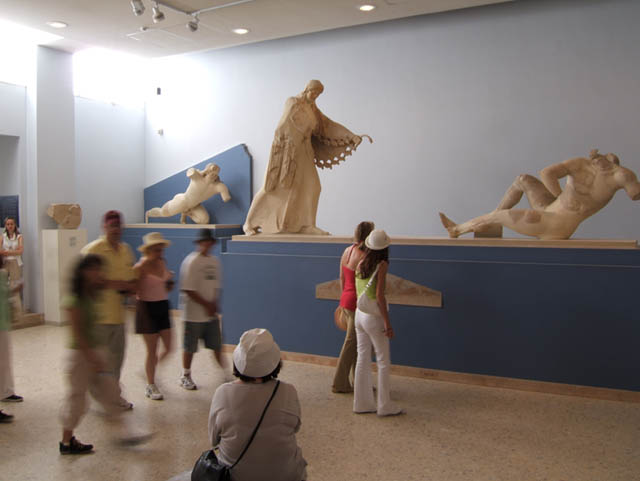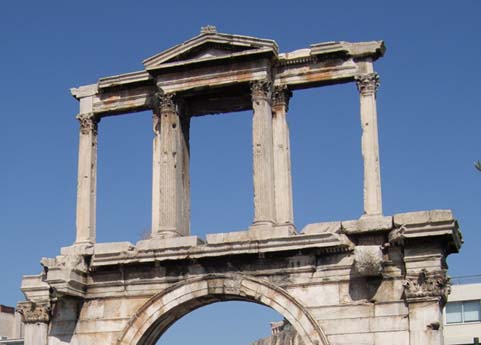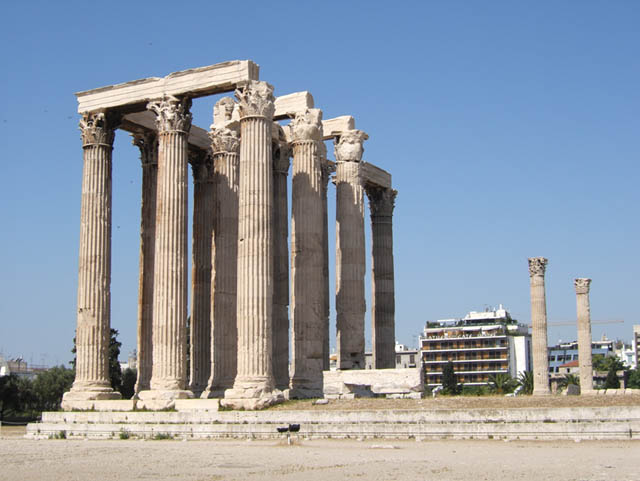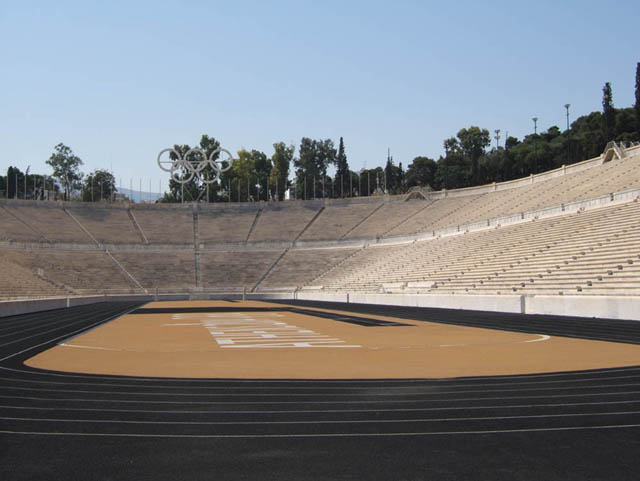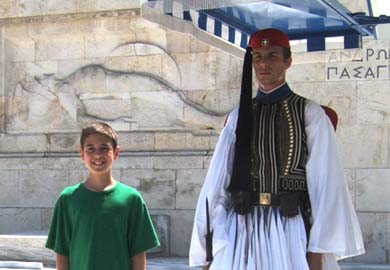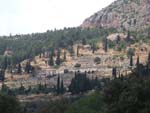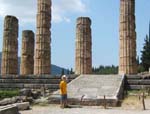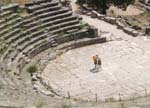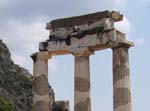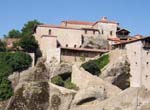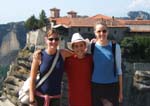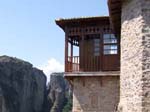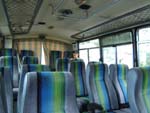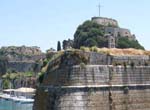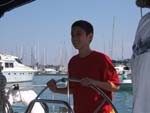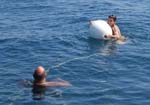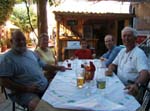 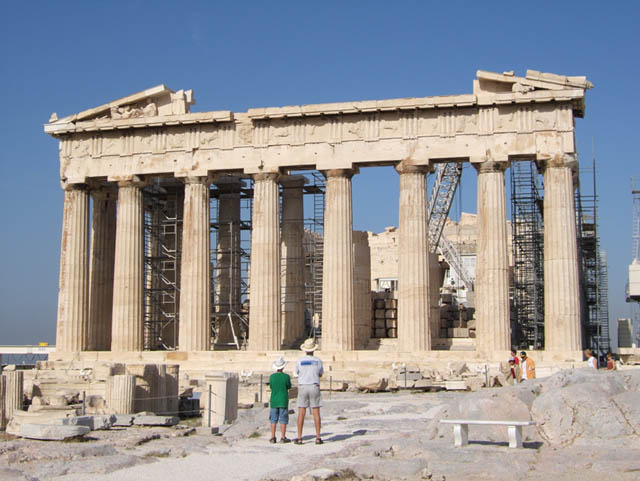 Greece There's only one morning ferry to Rodos (or Rhodes) from Marmaris and it's a fast one. Before we knew it we were unloading outside the old town and standing in line for passport control to enter Greece. The first order of business was to find lodging and a ferry schedule to other islands of the Dodecanese. Where we went next would depend on where ferries were going the next morning. Frank had left our Aegean schedule open to give us latitude in our choice of destinations. Our first choice was Thira (Santorini). Unfortunately, the time involved in getting there and difficulty getting anywhere else ruled it out. Difficulties were compounded by the fact that the ferry companies did not provide information on schedules from other islands. All they'd tell us was how we could get off this island and not what options we had from other islands. This would turn out to be a recurring theme. We had plenty of time to decide on our next day's destination so it was off to the Palace of the Grand Masters. Grand Master was the title given to the head of the Knights of St. John, a monastic military order (if that makes sense) that fortified and protected the island from 1306 to 1519. The palace is very well preserved and has magnificent Roman floor mosaics from the island of Kos. Rodos was once home to the Colossus of Rhodes, one of the 7 wonders of the ancient world. Built in 305 BC the Colossus probably stood at the Temple of Apollo, the location now occupied by the palace. An earthquake in 227 BC brought the big guy down and it's anybody's guess what became of him after that.
Patmos We decided on Patmos as our next day's destination. There was a fast morning ferry from Rodos and from Patmos we could easily reach Siros, a big ferry hub. At least that's what the travel agent in Rodos told us. Frank had the idea of carrying a sign when we disembarked that said, "We need a room". It wasn't necessary. There was a crowd of people at the ferry landing holding everything from business cards to posters with photos of their rooms. I recommend choosing the most sincere sounding person, preferably one that reminds you of someone's mom, and follow them. This worked for us. Not only did we get a great rate but we had a large new suite with air conditioning, kichenette, and porch. Patmos has long been a place of pilgrimage. St. John was exiled here in AD 95 and is said to have dictated Revelations in a cave above the modern day town of Skala. A 17th-century building now surrounds the Holy Cave of the Apocolypse. The fortified Monastery of St. John, dedicated in 1088, is one of the most important places of worship among Orthodox and Western Christians. The Treasury is a small museum that displays some of the monastery's thousands of documents, relics, and Byzantine works of art from the 11th to the 18th century.
It turned out that the travel agent on Rodos didn't tell us the whole story about getting off Patmos. While there are daily ferries to Pireas and Rodos, getting to the other islands we wanted to visit wasn't so easy. In fact, it couldn't be done within our schedule. By far the most helpful travel person we met wasn't even in the travel business. A friendly Australian woman named Joe at a local restaurant offered some ideas and suggested Astoria Travel, who turned out to be the most helpful travel folks we talked to and gave us ferry information on other islands. Unfortunately, it didn't do us any good; our only option was a midnight ferry to Pireas (Athens). By the way, the restaurant where we met Joe, Avgerinos, has great pitas at great prices. Athina
(Athens) We're here in the smoggy orange air of Athens. After a week visiting small picturesque towns, Athens brings us back to the big city. Our first stop is the National Archaeological Museum, remodeled for the 2004 Olympic Games, and quite nicely at that. Frank's favorite is the bronze Poseidon from about 460 BC and a key reason he brought Kevin here. The Mycenean gold and Thira frescoes aren't to be missed, either. Artifacts from the Antikytheran wreck are on display, including the intricate navigational Antikytheran mechanism. The museum has some interesting photo policies so be prepared if you go.
The excellent exhibit renovations have moved the National Archaeological Museum into a place among the world's must-see museums. Unfortunately, their generally indifferent consideration of visitors diminishes the experience.
Early in the morning is the best time to see the Acropolis. The light is good and the day's heat hasn't hit yet. I could tell you the place is deserted first thing on a Sunday morning, but it isn't. Tour groups are a fact of life. Like the National Archaeological Museum, the Acropolis has an unposted and arbitrary bags policy. If the ticket person thinks yours is too big you'll be sent to Cloak Check; different ticket takers have different bag size limits. After being leveled by the Persians in 480 BC, Pericles started rebuilding the Acropolis around 430 BC. The Parthenon is the largest Doric temple completed in ancient Greece and the only one built entirely of marble (roof excluded). It housed the statue of Athena and the treasury. The Erechtheion is built on the most sacred Acropolis site and is named for a mythical king. It housed the cults of Athena, Poseidon, and Erichthonius and is one of the best existing examples of the Ionic style. If you squint your eyes you can see the major structures without all the scaffolding.
Hadrian's Arch and the Temple of Olympian Zeus are just a short walk from the Acropolis. Hadrian's Arch was built by the Roman Emperor Hadrian in AD 131 to mark the boundary between the ancient city and the new Athens of Hadrian. Only a few of the columns remain of the colossal Temple of Olympian Zeus (174 BC - AD 132) but the extant Corinthian columns are massive. Down the street is the stadium where the first modern Olympic Games were held in 1896. Frank had hoped to get a photo of Kevin running around the stadium track. Unfortunately, the stadium was closed to visitors about 2 years because of vandalism (according to a tour guide). We'll just have to imagine what the photograph would have looked like with Kevin running. Then we're off for the changing of the guards at Parliament, another Athens tradition.
We left Athens early and traveled by bus to Delphi, the center of the ancient Greek world and our first stop on the day's tour. We met Jennifer, a New Zealand pharmacist working in Great Britain and touring eastern Europe. This was a public holiday in Greece and admission to the site and museum were free. Delphi dates back to Mycenaean times when Gaea, the earth goddess, was worshiped. Then followed Themis, Demeter, Poseidon, and finally Apollo (in summer) and Dionysos (in winter) with the sanctuary reaching its peak in the 4th century BC. Most pilgrims came to offer expensive gifts to the Delphic Oracle and seek advice. Her earth-vapor induced ravings were translated into verse by an attending priest. Treasuries housed the fortunes paid by city-states following victories and the losers hoping for a better outcome the next time. City-states vied for control of the sanctuary with its divine oracle and riches. The Macedonians were the eventual victors.
Kevin and Jennifer delivered an impromptu performance at the theater and raced down the stadium track. We spent most of the day exploring the main sanctuary, gymnasium, Sanctuary of Athena Pronaia with its mystery tholos, and the museum. The museum exhibits showed their 2004 Olympic Games upgrades. The Charioteer is the climax and final exhibit with a room all is own. By mid-afternoon it was time to catch the bus to Larissa, then Trikala, and finally Kalambaka. We just made the last transfer to Kalambaka by a few minutes, thanks to a helpful bus driver who guessed our destination. Our group had grown to six with Dwayne and Jennifer, a Canadian couple we met along the way. It was a long day but we'd have morning light for the rocks and monasteries of Meteora.
Although it's unknown when monks and hermits first came to the area, they were present by the 11th century. Retreat became increasing popular and the first monastery was built by Athanasios in the 14th century. He called the rock on which he built the monastery Meteora ("in the air"), giving the area its name. More monasteries were added over the next few hundred years until the decline of monasticism in the 17th century. Six monasteries function today and are visited by pilgrims. It's a short bus ride from Kalambaka to Meteora, where the bus dropped us at the end of the road. The three monasteries we visited function mostly as museums. The Monastery of Transfiguration (1388) is the uppermost and was closed. A short walk down the road was the Monastery of All Saints Varlaam (1518) with a small but excellent museum and expansive views of the Stone Forest. The last one we had time for was the Roussanou Monastery (restored 1444), small but impressive. Our time was limited; the bus for Ioannina and Igoumenitsa left shortly after 3 pm. Most of the road between Kalambaka and Igoumenitsa winds tightly through the mountains of northern Greece. It took several hours to get to Ioannina and we didn't arrive in the coastal town of Igoumenitsa until after 9 pm. We boarded a ferry for Corfu and dined at our hotel there about midnight.
Although many tourists and cruise ships visit the island for shopping and beaches, we were there to visit Frank's friends. After taking care of laundry and travel arrangements we spent the afternoon with Fred and Phyl aboard Perception. Fred showed Kevin how to steer the boat and they swam as we drifted off the coast. Following a memorable dinner at 'Chicken' George's we were on the 8 pm ferry back to Igoumenitsa to catch the midnight ferry to Bari, Italy. |
